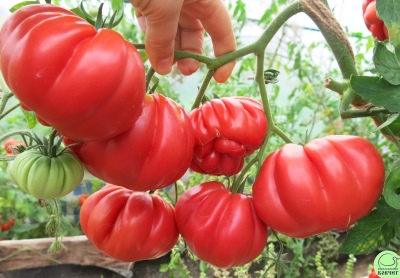
- Category: grade
- Growth type: determinant
- Appointment: fresh consumption, for juice, for ketchup and tomato paste
- Ripening period: late ripening
- Ripening time, days: 115-125
- Growing conditions: for film greenhouses, for greenhouses
- Transportability: No
- Bush size: medium-sized
- Bush height, cm: 150
- Foliage: medium
For those gardeners who appreciate not only the taste of the fruit, but also their appearance, the incredible American ribbed variety has been developed. The fruits in the section resemble a chrysanthemum flower, and from the outside they look like miniature pumpkins.
Despite the average yield, this tomato variety is ideal for greenhouse conditions in most regions of the Russian Federation, and in especially warm areas, summer residents grow crops in the open field.
Description of the variety
The American ribbed variety belongs to determinant crops. The bushes are medium-sized, they reach no more than 150 cm in height, which makes it possible to form a stem from the plant. The culture has medium leafiness, the leaf plates have a weakly pronounced relief, a rich bright green hue. Leaf veins are thin, level with the leaf surface.
A tomato bush should be formed into 2 stems, and to obtain a large specimen, it is worth leaving one main shoot.
The main qualities of the fruit
Fruits of the American ribbed flattened, rounded, the ribs are very prominent. Ripe fruits have a rich red color, uniform color, unripe fruits will be green, with light spots. The tomato peel is dense, with a light waxy bloom, does not crack. In the section of the fetus, the shape and structure of the ribs and the core can be traced.
The weight of one fruit reaches 400 g. To the top of the shoot, the fruits become slightly smaller, which is ideal for rolling up and preserving the product. The keeping quality of tomatoes is high, which allows them to be stored for a long time.
Taste characteristics
The flesh of the American ribbed is firm, juicy, rather fleshy. The amount of dry matter is only 6%. Decent taste, pleasant aroma.
Ripening and fruiting
This variety is late-ripening, the ripening period is 115-125 days from the date of sowing the seeds. Harvesting is carried out at the end of summer.
Yield
Up to 3 kg of tomatoes can be removed from one bush, and up to 12 kg from 1 m2 of planting, therefore, American ribbed is classified as a type of medium-yielding hybrids. The fruits ripen almost simultaneously, so it will not be possible to be content with tomatoes throughout the entire fruiting period.
The timing of planting seedlings and planting in the ground
Sowing of seeds is carried out at the end of March. Seedling care is standard, as for all plants. Planting holes for future bushes in the greenhouse are prepared in advance. In late spring or early summer, young plants are transplanted into them. If a temporary film cover is used, then the seedlings are planted in mid-May.

Growing tomato seedlings is an extremely important process, because it largely depends on whether the gardener can harvest at all. All aspects must be taken into account, from seedbed preparation to planting in the ground.
Landing scheme
The young culture is not planted very tightly in the pits: the distance between the plants should be 70 cm, between the rows of the beds - 40 cm. You should not grow more than 3-4 plants per 1 m2 of area.Exceeding the indicators will lead to a poor harvest and poor plant development due to the fact that the root system of each bush will not have enough space and nutrients.

Growing and care
During the cultivation of tomato, bushes must be formed by removing excess shoots during the growing season and fruiting. Also, the plants must be tied up, despite the fact that the trunk of the culture is strong: under the weight of the fruits, it can easily break. Pickling is also necessary if you want to achieve a good harvest.
Like all crops of the Solanaceae family, the American ribbed requires fertilizing with mineral fertilizers during growth, laying flower ovaries and fruits. The feeding scheme is standard for all types of tomatoes. Also, do not forget about weeding and mulching the trunk circle to protect the soil from pests and reduce moisture evaporation from the greenhouse substrate.




A plant needs different micronutrients at each stage of growth. All fertilizers can be divided into two groups: mineral and organic. Folk remedies are often used: iodine, yeast, bird droppings, eggshells.
It is important to observe the rate and period of feeding. This also applies to folk remedies and organic fertilizers.
Disease and pest resistance
American ribbed tomatoes are quite resistant to fungal diseases, but with improper agricultural technology, they can be affected by late blight. If signs of this disease are found on the plant, the bush must be treated with a fungicidal preparation according to the instructions.
Of the pests, tomatoes are affected by the scoop and spider mite. To combat them, there are special insecticidal preparations, such as "Strela" and "Fitoverm".
Growing American ribbed tomatoes is an easy task. The culture is distinguished by its unique fruit shape and its resistance to disease. Dense red tomatoes of this variety are ideal for most types of preparations, sauces, salads.



























































































